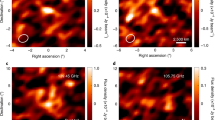Abstract
Long-period comets are, on average, more luminous than short-period ones. This paper considers the recent observations of the nucleus of comet Halley, in conjunction with the results of the modelling of the accretion process that is most probably responsible for cometary origin. It now seems that simple physical processes such as a rounding off and removal and/or settling of bumps and prominences protruding from the nucleus plus a change in the percentage of the nucleus surface that is active could account for the fading that occurs just after jovian cometary capture.
This is a preview of subscription content, access via your institution
Access options
Subscribe to this journal
Receive 51 print issues and online access
$199.00 per year
only $3.90 per issue
Buy this article
- Purchase on Springer Link
- Instant access to full article PDF
Prices may be subject to local taxes which are calculated during checkout
Similar content being viewed by others
References
Vsekhsvyatskii, S. K. in Fizicheskie Kharaktenstiki Komet (Moscow, 1968) (Translated as Physical Characteristics of Comets, Israel Program for Scientific Translations, Jerusalem, 1964).
Vsekhsvyatskii, S. K. Soviet Astr. 6, 849–854 (1963).
Vsekhsvyatskii, S. K. Soviet Astr. 8, 429–431 (1964).
Vsekhsvyatskii, S. K. Soviet Astr. 10, 1034–1041 (1967).
Vsekhsvyatskii, S. K. in The Motion, Evolution of Orbits and Origin of Comets (ed. Chebotarev, G. A. & Kazimirchak-Polonskaya, E. I.) 9–15 (Reidel, Dordrecht, 1972).
Vsekhsvyatskii, S. K. & Il'ichishina, N. I. Soviet Astr. 15, 310–313 (1971).
Hughes, D. W. Contemp. Phys. 23, 257–283 (1982).
Whipple, F. L. Mem. Soc. R. Sci. Liege Ser. 6 9, 101–111 (1976).
Öpik, E. J. Astrophys. space Sci. 21, 307–398 (1973).
Hughes, D. W. Mon. Not. R. astr. Soc. 213, 103–109 (1985).
Hughes, D. W. Phil. Trans. R. Soc. (in the press).
Keller, H. U. et al. Nature 321, 320–326 (1986).
Hughes, D. W. Mon. Not. R. astr. Soc. 204, 1291–1295 (1983).
Everhart, E. Astrophys. Lett. 10, 131 (1972).
Fernandez, J. A. Astr. Astrophys. 96, 26 (1981).
Fernandez, J. A. & Ip, W. A. in Asteroids, Comets and Meteors (ed. Lagerkvist, C. I. & Rickman, H. 387–390 (University of Uppsala Press, 1983).
Daniels, P. A. & Hughes, D. W. Mon. Not. R. astr. Soc. 195, 205–212 (1981).
Donn, B. & Hughes, D. W. Bull. Am. astr. Soc. 17, 689 (1985).
Daniels, P. A. & Hughes, D. W., Mon. Not. R. astr. Soc. 195, 1001–1009 (1981).
Hughes, D. W. & Daniels, P. A. Mon. Not. R. astr. Soc. 198, 573–582 (1982).
Hughes, D. W. Mon. Not. R. astr. Soc. (in the press).
Kresák, Ľ. in Comets (ed. Wilkening, L. L.) 56–82 (University of Arizona Press, 1982).
Author information
Authors and Affiliations
Rights and permissions
About this article
Cite this article
Hughes, D. Cometary magnitude distribution and the fading of comets. Nature 325, 231–232 (1987). https://doi.org/10.1038/325231a0
Received:
Accepted:
Issue Date:
DOI: https://doi.org/10.1038/325231a0
This article is cited by
-
Modeling of cometary evolution by kinetic theory: Method and first results
Earth, Moon, and Planets (1996)
-
Comets
The Astronomy and Astrophysics Review (1993)
-
Effects of cesium on cellular systems
Biological Trace Element Research (1993)
-
Structure and evolution of the Jupiter family
Celestial Mechanics and Dynamical Astronomy (1992)
-
Cytotoxicity of equinatoxin II from the sea anemoneActinia equina involves ion channel formation and an increase in intracellular calcium activity
The Journal of Membrane Biology (1990)
Comments
By submitting a comment you agree to abide by our Terms and Community Guidelines. If you find something abusive or that does not comply with our terms or guidelines please flag it as inappropriate.



